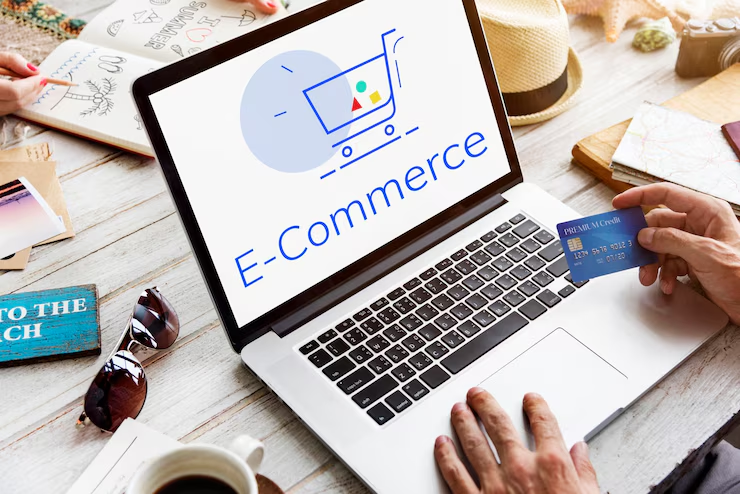
The Evolution of E-Commerce
E-commerce, or electronic commerce, refers to the buying and selling of goods and services over the internet. It encompasses various online business activities, including retail, wholesale, and digital services, enabling businesses and consumers to transact digitally without physical interactions. E-commerce has grown rapidly in recent years, driven by advancements in technology, changes in consumer behavior, and the rise of digital platforms.
Key Components of E-Commerce
- Online Retail Stores Online retail stores are digital platforms where businesses sell products directly to consumers. These stores can range from large marketplaces to niche boutique shops.
- Advantages: Online retail stores offer convenience, allowing consumers to shop from anywhere and at any time. They provide a wide range of products and often feature user-friendly interfaces and secure payment options.
- Examples: Major online retail stores include Amazon, eBay, and Alibaba.
- E-Commerce Platforms E-commerce platforms are software solutions that enable businesses to create and manage online stores. These platforms offer tools for product listing, payment processing, order management, and customer service.
- Advantages: E-commerce platforms streamline the setup and management of online stores, providing features such as inventory management, marketing tools, and analytics.
- Examples: Popular e-commerce platforms include Shopify, WooCommerce, and Magento.
- Digital Payment Systems Digital payment systems facilitate online transactions by providing secure methods for processing payments. These systems include payment gateways, digital wallets, and online banking services.
- Advantages: Digital payment systems offer secure and efficient transaction processing, reducing the need for physical cash and improving payment convenience.
- Examples: Common digital payment systems include PayPal, Stripe, and Apple Pay.
Trends in E-Commerce
- Mobile Commerce (M-Commerce) Mobile commerce refers to the use of mobile devices, such as smartphones and tablets, to conduct online transactions. With the increasing use of mobile devices, m-commerce has become a significant trend in e-commerce.
- Growth: The proliferation of mobile devices and improved internet connectivity have driven the growth of m-commerce. Mobile-friendly websites and apps are essential for capturing this market segment.
- Features: Mobile commerce includes features such as one-click payments, mobile-optimized shopping experiences, and location-based services.
- Omni-Channel Retailing Omni-channel retailing involves providing a seamless shopping experience across multiple channels, including online, mobile, and physical stores. It integrates various touchpoints to create a unified customer experience.
- Integration: Successful omni-channel retailing requires integrating online and offline sales channels, inventory systems, and customer service.
- Benefits: Omni-channel strategies improve customer satisfaction by offering flexible shopping options and consistent experiences across channels.
- Artificial Intelligence (AI) and Machine Learning AI and machine learning technologies are increasingly being used in e-commerce to enhance personalization, improve customer service, and optimize operations.
- Personalization: AI algorithms analyze customer data to provide personalized product recommendations, targeted marketing, and tailored shopping experiences.
- Customer Service: AI-powered chatbots and virtual assistants offer 24/7 customer support, handling inquiries and providing assistance in real-time.
- Social Commerce Social commerce involves using social media platforms to facilitate e-commerce transactions. It combines social networking with online shopping, allowing users to discover and purchase products directly through social media.
- Integration: Social commerce integrates shopping features into social media platforms, such as Facebook Shops, Instagram Shopping, and Pinterest Buyable Pins.
- Influence: Social media influencers and user-generated content play a significant role in driving engagement and sales in social commerce.
- Subscription-Based Models Subscription-based models involve offering products or services on a recurring basis, often through monthly or annual subscriptions. This model provides a steady revenue stream and enhances customer loyalty.

- Types: Subscription-based models include product boxes, streaming services, and software-as-a-service (SaaS) platforms.
- Benefits: Subscription models offer convenience, cost savings, and personalized experiences, attracting customers who prefer ongoing access to products or services.
Challenges in E-Commerce
- Cybersecurity Threats Cybersecurity threats pose significant risks to e-commerce businesses and consumers. Ensuring the security of online transactions and protecting sensitive customer data are critical concerns.
- Threats: Common cybersecurity threats include data breaches, phishing attacks, and malware. E-commerce businesses must implement robust security measures to mitigate these risks.
- Solutions: Solutions include using encryption, implementing secure payment gateways, and regularly updating software to address vulnerabilities.
- Customer Privacy and Data Protection Protecting customer privacy and ensuring data protection are essential for building trust and maintaining compliance with regulations.
- Regulations: E-commerce businesses must comply with data protection regulations, such as the General Data Protection Regulation (GDPR) and the California Consumer Privacy Act (CCPA).
- Best Practices: Best practices include obtaining explicit consent for data collection, providing transparency about data usage, and implementing strong data protection measures.
- Logistics and Supply Chain Management Efficient logistics and supply chain management are crucial for timely order fulfillment and customer satisfaction.
- Challenges: Challenges include managing inventory, handling shipping and delivery, and coordinating with suppliers and fulfillment centers.
- Solutions: Solutions include using technology to optimize inventory management, employing data analytics for demand forecasting, and partnering with reliable logistics providers.
- Customer Retention and Engagement Retaining and engaging customers is essential for long-term success in e-commerce. Businesses must focus on delivering exceptional experiences to keep customers coming back.
- Strategies: Strategies for customer retention include offering loyalty programs, personalized marketing, and responsive customer service.
- Engagement: Engaging customers through interactive content, social media, and targeted promotions can enhance brand loyalty and drive repeat purchases.
The Future of E-Commerce
- Growth of Emerging Markets Emerging markets are expected to experience significant growth in e-commerce as internet penetration and digital adoption increase.
- Opportunities: Businesses can tap into new market opportunities by expanding their reach to emerging regions and adapting their strategies to local preferences and behaviors.
- Challenges: Challenges include navigating regulatory environments, managing logistics, and addressing cultural differences.
- Advancements in Technology Technological advancements will continue to shape the future of e-commerce, driving innovation and improving the online shopping experience.
- Blockchain Technology: Blockchain technology has the potential to enhance transparency, security, and efficiency in e-commerce transactions.
- Virtual and Augmented Reality: Virtual and augmented reality technologies can create immersive shopping experiences, allowing customers to visualize products in new ways.
- Sustainability and Ethical Practices Consumers are increasingly concerned about sustainability and ethical practices in e-commerce. Businesses that prioritize environmental and social responsibility will likely gain a competitive advantage.
- Sustainable Practices: Adopting sustainable practices, such as eco-friendly packaging and responsible sourcing, can appeal to environmentally conscious consumers.
- Ethical Sourcing: Ensuring ethical sourcing and fair labor practices can enhance brand reputation and build trust with customers.
Conclusion
E-commerce has transformed the way businesses and consumers interact, offering convenience, efficiency, and a wide range of products and services. Key trends such as mobile commerce, omni-channel retailing, and advancements in technology are driving the evolution of e-commerce. However, challenges such as cybersecurity threats, customer privacy, and logistics must be addressed to ensure continued success. As the industry evolves, businesses must adapt to emerging trends, embrace technological advancements, and prioritize sustainability to stay competitive and meet the changing needs of consumers. The future of e-commerce holds exciting possibilities, with opportunities for growth, innovation, and enhanced customer experiences.
[…] The repayment schedule outlines when and how much the borrower must pay. It includes the frequency of payments (e.g., monthly, bi-weekly) and the due dates. Some loans may offer flexible repayment options or allow for extra payments without penalties. […]